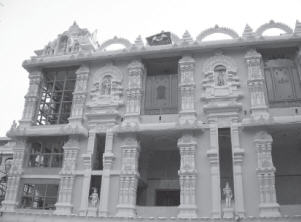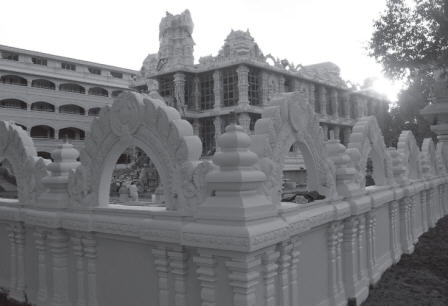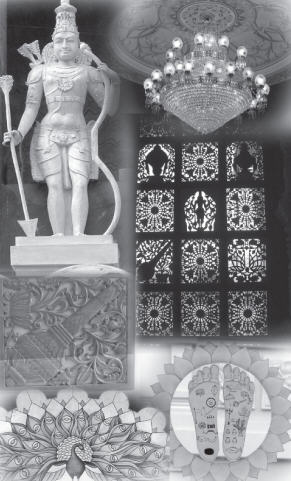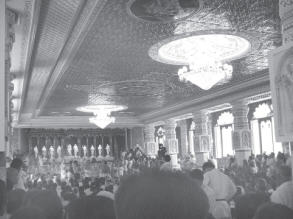
India, the land of religion is a land where even the demigods aspire to take birth, because it offers, like no where else, a chance to achieve perfection in spiritual life. A land where every place oozes spiritual energy arising from countless religious practices, penances, sacrifices, and chanting done by her inhabitants since time immemorial. A land where the sages enacted numerous temples and pilgrimage places so that people could visit them and hear the topics of God from self-realized souls. One such sage walked on this land in modern times. This is a story of his vision to build a center of divine knowledge. A story also of his followers' hard struggle to fulfill that vision and the wonderful monument they finally created as an offering their glorious preceptor.
We take the readers to Tirupati, in Andhra Pradesh, the home of the richest temple in the world where thousands visit daily to take darsana of the Supreme Lord Balaji The year is 1974. His Divine Grace A.c. Bhaktivedanta Swami Prabhupada, the Founder Acarya of the International Society for Krishna Consciousness, (ISKCON), a movement propagating teachings of Lord Krsna, was invited as a special guest of the Government of Andhra Pradesh. While in Tirupati, He stayed at the Tirumala hills, where the famous temple is situated and went three or four times daily to see the Deity of Balaji. Whenever he went, the pujaris would clear the inner sanctum of all other visitors and allow him a private darsana for as long as he liked, standing in the torchlight before the mystical, bejeweled form of Balaji.
He was very much impressed by the management of the temple, but his heart contemplated a much vaster plan to please the Lord – by spreading His message. During his discussion with the then Endowments Minister of A.P. Sri Sagei Suryanaryanna Raju, Srila Prabhupada expressed these thoughts. "Since T.T.D (the management committee of Tirumala Balaji Temple) had the basic infrastructure," he suggested, "it should work out some program and take the assistance of the devotees of ISKCON to conduct vigorous preaching for the benefit of all ."
For his followers Srila Prabhupada had another message: We should build temples like this Venkateswara Temple, which has a gold dome and wonderful facilities for visiting pilgrims.
THE BEGINNING

In 1982, T.T.D. provided a beautiful, large piece of land at the foot of the Divine Tirumala Hills. Later, on inspiration of His Holiness Bhaktisvarupa Damodara Swami, a disciple of Srila Prabhupada, the devotees installed the Deities of Sri Sri Radha Govinda and inaugurated a small temple on 10th April 1984. Things slowed down thereafter.
In 1996, His Holiness jayapataka Swami, the G.B.C for Tirupati, revived the project. He appointed Revati Ramana Dasa as temple president and asked him to whole-hearredly accept this project as his life and soul. But it was not easy,
"I began with a handful of devotees and meagre finances," says Revati Ramana Dasa, "but by the mercy of the Lord we carried on and in 1999 we held the ground breaking ceremony for a new magnificent temple. Slowly devotees starred joining and the brahmacaris asrama developed. With the help of the dedicated brahmacaries and the blessings of all the vaisnavas the things really got going."
BOOKS ARE THE BASIS
To collect the funds for the temple Revati Ramana Dasa employed a strategy that so far wasn't tested in India. Whereas the temples in the West rely heavily on book distribution to earn revenue, in India the emphasis is more on collecting funds in charity from rich donors. But Tirupati is purely a pilgrimage place without much business or industry; the major source of livelihood for the locals is Balaji darsana. "So we decided to develop a big book distribution program," says Revati Ramana Dasa. "And what better place than Tirupati to do so? Every day nearly 50 thousand people visit this holy place not just from India but the whole world. From here we could preach to the entire world."
The T.T.D. granted ISKCON an unheard-of concession permission to distribute Srila Prabhupada's books in the temples under its jurisdiction. Many other religious groups have tried to get places in T.T.D temples but they failed. "ISKCON is exception," says Revati Ramana Dasa, "T.T.D people like us because we are preaching the same age-old Sanatana dharma that they follow. We do not deviate or concoct anything, and simply spread the prescribed spiritual practice of this age – chanting the holy names of the Lord."
Each day the devotees set up six book tables – two stalls up in Tirumala hills, one each at Govindaraja and Padmavati temple, and two stalls in ISKCON temple. Tens of thousands of people see the devotees and interact with them and thousands of Krishna Consciousness books are distributed everyday. No doubt, ISKCON Tirupati is amongst the top temples in the world in book distribution. Of the estimated 20 crore rupees spent on temple construction nearly sixty percent was raised through book distribution.
THE TEMPLE

The first thing that strikes a new visitor to ISKCON Tirupati is the sheer amount of multi-coloured signs, bill-boards, and invitations that line the streets. Boldly promoting Bhagavad-gita As It Is and describing the various world-wide activities of ISKCON and Srila Prabhupada, they are absolute delight to read. There are more than forty different varieties of them! Near the temple there are about a dozen billboards with beautiful pictures of Srila Prabhupada – each proclaiming the wonderful gifts that Srila Prabhupada has given to the world.
The temple is a beautiful synthesis of traditional South Indian temple architecture and modern facilities. It is located at the foothills of the divine Tirumala Hills, which are the incarnation of Lord Ananta Sesa. Thus, Lord Ananta Sesa mercifully bestows His darsana to all the devotees throughout the day.
The eastern side of the temple has a welcome tower where slow running water bathes the feet of visiting devotees. From there one steps in to the temple compound and is bedecked by the marvellous structure. Shaded in light blue colour with the decorations of different Avataras and domes highlighted with gold, the temple takes one's breath away. Pink lotus petals encircle the temple base and open up allowing a flight of marble stairs. As one reaches the final step, ornately carved wooden doors greet him and lead to two winding staircases that ascend up to the temple hall.
The temple hall is a masterpiece in decoration. The ceiling is first to attract the eyes with a central Thanjavur style painting of Rasa dance. The divine couple Sri Krsna and Srimati Radharani dressed and posing in South Indian style are surrounded by Their dancing associates – all decorated by golden embroidered garments. Golden crisscross designs stand out at the red ceiling. Huge chandeliers at the centre and delicate ones, which slowly rotate around their central axis, line the periphery. Large ornate pillars, well placed off to the sides so as not to obstruct vision, have square middle portions with beautifully carved pastimes of Dasavataras, Lord Caitanya, Lord Krsna and Lord Balaji. Hand painted designs and symbols are everywhere. Large three piece windows with fixed middle piece have coloured, etched designs including those of Lord Caitanya, Nityananda, and the lotus feet of Radha and Krsna with all the auspicious markings. Before the windows begin and where they end are four wonderful bas-reliefs of different pastimes, with carved wooden frames. The floor is no less – intricate marble designs match every bit of the artwork around. All lead up to a large ornately carved wood altar highlighted in gold where Sri Sri Radha-Govinda, Asta Sakhis, and Giriraja preside. Unique feature of the altar is that its almost 40 foot span is completely open without a single column in the front. The temple domes have the sculptures of Visnu, Nrsimha, Lord Rama , and Lord Krsna. On the external walls of the temple one sees beautiful figures of the dasavataras. The temple has one Raja Gopuram (tower), one Swagata Gopuram (welcome tower), one Vimana gopuram (tower above sanctum sanctorum) and four corner gopurams indicating the four yugas.

It is the first temple in south India and the second in the world, after ISKCON Mayapur, to have Radha Krsna with Asta sakhis.
The temple is designed to impart spiritual training an deducation. Thus the basement has a multimedia theatre with sitting capacity of three hundred and the ground floor has an exhibition cum community hall that can seat one thousand people. There is also a well-furnished guest house and a Govinda's restaurant.
It is the first temple in south India and the second in the world, after ISKCON Mayapur, to have Radha Krsna with Asta sakhis.
The temple is designed to impart spiritual training and education. Thus the basement has a multimedia theatre with sitting capacity of three hundred and the ground floor has an exhibition cum community hall that can seat one thousand people. There is also a wellfurnished guest house and a Govinda's restaurant.
PROJECTS
The Tirupati ISKCON temple is not only actively pursuing book distribution but also has numerous programs to reach out to the community.
PREACHING PROGRAMS:
Sreyas: It's a youth program with membership of more than 400 students, mostly doctors from a local medical college. They meet every Sunday and discuss Krsna Conscious philosophy and have question and answers session.
Samarpan: A program for married house holders, its held every fourth Sunday and conducted personally by Revati Ramana Dasa.
Brahmacari Asrama: The temple currently has eighty full time residents most of whom were attracted by the book distribution programs. The essential principle of good sadhana, vaisnava etiquette, and mood of humble menial service is imparted. When a new devotee joins his initial service includes working in the cow-shed, helping in food for life kitchen , cleaning pots in the Deity kitchen, cleaning of toilets, and book distribution.
Congregation Preaching: There are around 1500 congregation devotees and they actively participate in various temple activities including book distribution . Ladies string garlands for the Deities and also stitch the dresses. Beads and pearls jewellery is made by the brahmacaries.
Every Sunday there is nagar sankirtana in which 80- 100 devotees take part. They go to one locality and perform harinam sankirtana. The people always welcome this event with an open heart.
The future vision is to provide spiritual training, entertainment and association and to promot e and introduce the rich culture and heritage of Santana dharma to the thousands of pilgrims visiting this holy site by fulfilling the purposes of ISKCON systematically.
Food for Life: Currently feeding prasadam to 12,500 under-privileged school children . There are plans to double the number in the coming academic session.
Farm Community: 5-7 acres of farm is located fifty kilometers away from the temple. A grhastha family is in charge of the project and supplies vegetab les for the prasadam cooking.
Gosala: Presently has 80 cows whose milk is used for cooking for the Deities. School: A day school built on the land donated by T.T.D. has hundred children from class 1- 7. Their curriculum includes, apart from the regular studies, Vaisnava songs, slokas recitation , and Vaisnava etiquette. After the morning prayers that include Mangalacarana, and guru paja the students come for darsana of the Deities and recite Hare Krsna mahamantra to Them.
Through out the ISKCON world devotees of ISKCON Tirupati are recognized for their service attitude, Vaisnava seva, humble, gentle, co-operative, and 1oving, nature and these qualities were in full display during the installation festival.
Once in New Vrndavana, USA, devotees told Srila Prabhupada that one day ISKCON temples would be as opulent as the buildings in spiritual world, which are lit up by bright jewels and precious stones . Srila Prabhupada stopped and turning around to face the huge number of devotees all around he said, "My devotees are the real jewels!" Same can be said about the devotees of ISKCON Tirupati. They are the living jewels that beautify the temple.
THE FUTURE
Srila Prabhupada once said that the remains of Vedic culture can now only be seen in South India. The residents here are naturally pious and are mostly Sri Vaisnavas, the devotees of Laksmi-Narayana. Being one of the major pilgrimage places of the Sri Vaisnavas, Tirupati is non- different from Vaikuntha, the abode of Lord Narayana. Here the worship af Lord Narayana is in mood of awe and reverence. It lacks the intimate loving sentiments with which the inhabitants of Vraja serve Krsna. This mood of loving service following in the footsteps of Vrajavas is is the gift which Lord Caitanya descended to bestow upon this world. Now by making this temple of Radha- Krsna and Lord Caitanya, the devotees of ISKCON Tirupati have brought the love of Vrndavana for everyone. Thus not only Srila Prabhupad a's long cherished desire has been fulfilled, but also the doors of Goloka have been opened for the residents of Vaikuntha.
But is it possible to convince these devotees about the message of Lord Caitanya?
History is on our sid e . In Srimad-Bhagavatam, Narada Muni predicts about South Indian devotees of the Lord as follows:
My dear King, the inhabitants of Satya-yuga and other ages eagerly desire to take birth in this age of Kali, since in this age there will be many devotees of the Supreme Lord, Narayana. These devotees will appear in various places but will be especially numerous in South India. O master of men, in the age of Kali those persons who drink the waters of the holy rivers of Dravida-desa, such as the Tamraparni, Krtamala , Payasvini, the extremely pious Kaveri and the Pratici Mahanadi, will almost all be pure hearted devotees of the Supreme Personality of Godhead, Vasudeva. [S8 11.5.38-40]
When Lord Caitanya travelled to South India, thousands of people's hearts were transformed up on seeing Him and they wholeheartedly accepted devotion to Radha and Krsna. Even now, the residents here remain very open to the Gaudiya Vaisnavaism. "We have never faced any problem in preaching about Lord Caitanya here," confirms Madhu Gopal Dasa, a senior leader of the temple.
Any doubts that I had about South Indians accepting Lord Caitanya got removed on the final day of our stay. As I emerged from the 'Food for Life' kitchen carrying the prasadam for the train journey, I saw a South Indian family. There was a young couple with a little kid and an elderly grandmother. Together they entered from the eastern gopurum while Srila Prabhupada's rendition of Hare Krsna mahamantra was being played on the amplifier system. The dark complexioned , gray haired, grandmother with a bent back instantly broke into a toothless smile and began clapping and singing the mahamantra. The father turned to the kid and said, "Come on! Sing! Hare Krsna, Hare Krsna. Yes. Krsna Krsna, Hare Hare. Good . Hare Rama, Hare Rama, Rama Rama. Very good! Hare Hare. Again …. " More than three decades back Srila Prabhupada had desired to establish the worship of Radha-Krsna in South India. And now Revati Ramana Dasa and his dedicated crew of devotees have fulfilled that desire in the most wonderful way.
With inputs from Dinabandhu Dasa, Revati Ramana Dasa, Madhugopal Dasa, and Ram Murari Dasa from ISKCON Tirupati.
